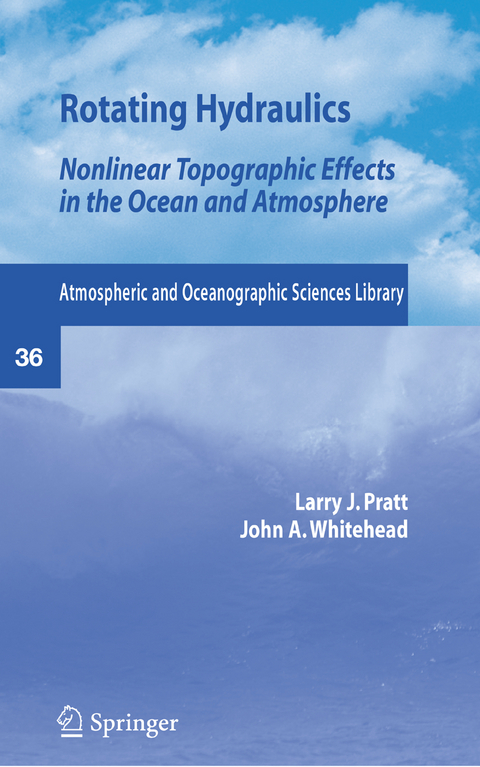
Rotating Hydraulics
Nonlinear Topographic Effects in the Ocean and Atmosphere
Seiten
2016
|
Softcover reprint of the original 1st ed. 2007
Springer-Verlag New York Inc.
978-1-4939-5043-0 (ISBN)
Springer-Verlag New York Inc.
978-1-4939-5043-0 (ISBN)
What is “rotating hydraulics” and why would anyone wish to read a book on the subject? The subject is also important for the study of the Earth’s climate because of the special opportunities for observation and long term monitoring made possible as a result of the choking effect.
What is “rotating hydraulics” and why would anyone wish to read a book on the subject? Over the past three decades, the term has come to describe the physics of overflows and other choked flows of the ocean and atmosphere that are broad enough to be influenced by Earth’s rotation. The currents and winds in question typically have high speeds, subcritical-to-supercritical transitions, shocks, and other objects familiar to open-channel or aeronautical engineers. Bores, int- sions, steepening waveforms and separation phenomena are considered part of the subject because they tend to arise within these flows. Mixing with neighboring fluid often occurs as the result of wave breaking or of instabilities associated with the high velocities. Interest in the field is often excited by the dramatic and strongly nonlinear character of the features in question and by the mixing and its downstream consequences. The subject is also important for the study of the Earth’s climate because of the special opportunities for observation and long term monitoring made possible as a result of the choking effect. This book is concerned primarily with the theory of rotating hydraulics. However, the Introduction contains an overview of the observations that have motivated much of the theoretical development, and more detailed case studies appear later in the book. Though both the atmosphere and the ocean are covered, the latter is the source of the most numerous examples.
What is “rotating hydraulics” and why would anyone wish to read a book on the subject? Over the past three decades, the term has come to describe the physics of overflows and other choked flows of the ocean and atmosphere that are broad enough to be influenced by Earth’s rotation. The currents and winds in question typically have high speeds, subcritical-to-supercritical transitions, shocks, and other objects familiar to open-channel or aeronautical engineers. Bores, int- sions, steepening waveforms and separation phenomena are considered part of the subject because they tend to arise within these flows. Mixing with neighboring fluid often occurs as the result of wave breaking or of instabilities associated with the high velocities. Interest in the field is often excited by the dramatic and strongly nonlinear character of the features in question and by the mixing and its downstream consequences. The subject is also important for the study of the Earth’s climate because of the special opportunities for observation and long term monitoring made possible as a result of the choking effect. This book is concerned primarily with the theory of rotating hydraulics. However, the Introduction contains an overview of the observations that have motivated much of the theoretical development, and more detailed case studies appear later in the book. Though both the atmosphere and the ocean are covered, the latter is the source of the most numerous examples.
Lawrence Pratt is currently a senior scientist in the Department of Physical Oceanography at Woods Hole Oceanographic Institution. His main research interests cover the dynamics of meandering currents, especially the Gulf Stream and other separated western boundary currents. John A. Whitehead is currently a senior scientist in the Department of Physical Oceanography at Woods Hole Oceanographic Institution.
Review of the Hydraulics of Nonrotating, Homogeneous Flow.- The Hydraulics of Homogeneous Flow in a Rotating Channel.- Time-Dependence and Shocks.- Coastal Applications.- Two-Layer Flows in Rotating Channels.- Potential Vorticity Hydraulics.
| Erscheinungsdatum | 18.08.2022 |
|---|---|
| Reihe/Serie | Atmospheric and Oceanographic Sciences Library ; 36 |
| Zusatzinfo | XIII, 592 p. |
| Verlagsort | New York |
| Sprache | englisch |
| Maße | 155 x 235 mm |
| Themenwelt | Naturwissenschaften ► Geowissenschaften ► Geologie |
| Naturwissenschaften ► Geowissenschaften ► Geophysik | |
| Naturwissenschaften ► Geowissenschaften ► Hydrologie / Ozeanografie | |
| Naturwissenschaften ► Geowissenschaften ► Meteorologie / Klimatologie | |
| Naturwissenschaften ► Physik / Astronomie ► Strömungsmechanik | |
| Naturwissenschaften ► Physik / Astronomie ► Thermodynamik | |
| Technik ► Bauwesen | |
| Schlagworte | coast • Fluid Dynamics • global circulation • Hydraulics • jet stream • Marine • meteorology • ocean • Oceanography |
| ISBN-10 | 1-4939-5043-6 / 1493950436 |
| ISBN-13 | 978-1-4939-5043-0 / 9781493950430 |
| Zustand | Neuware |
| Haben Sie eine Frage zum Produkt? |
Mehr entdecken
aus dem Bereich
aus dem Bereich


